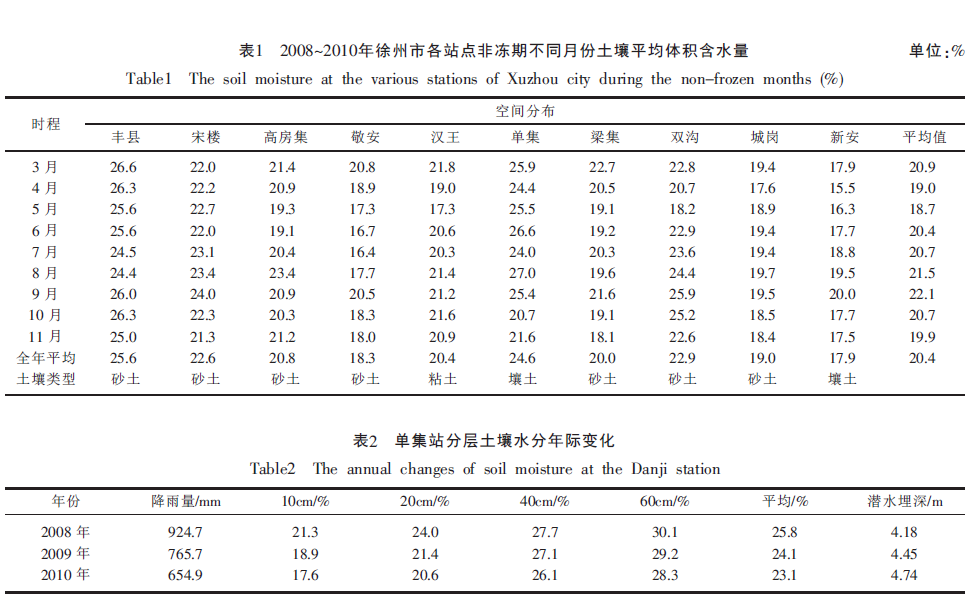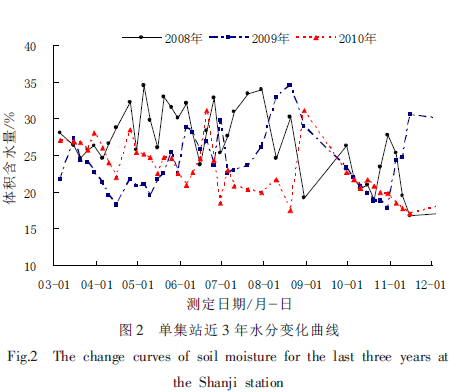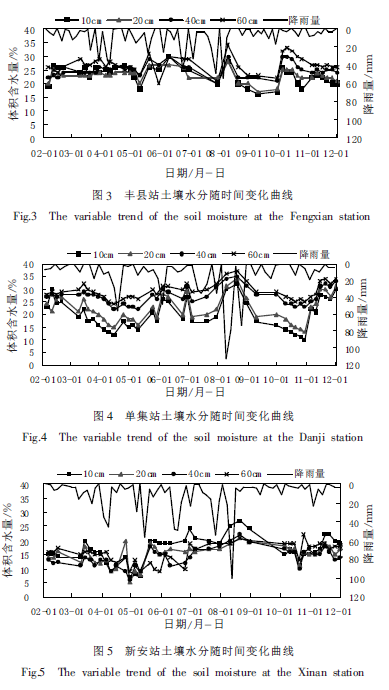Using the soil moisture observation data from 10 sites in Xuzhou from 2008 to 2010, the temporal and spatial variation of soil moisture in the region was analyzed. It was found that the soil moisture in Xuzhou was relatively high in the west and south, and was low in the east and north, and the soil moisture was low. Affected by precipitation and soil texture, less precipitation is the main reason for the poor soil moisture in Xuzhou in 2010.
1 Overview In recent years, with the global climate change, population growth, and rapid economic and social development, drought disasters have expanded, and their impact has spread from poor water areas to high water areas, extending from local to national, through recent years. Data analysis of the soil drought monitoring system shows that the losses caused by drought and water shortage are also getting worse. Xuzhou City is located in the southeast of the Huang-Huai-Hai Plain, which is an important food production area in China. In addition, the northern Jiangsu region where Xuzhou is located is relatively short of water, with a normal year of water shortage of about 30×108m3, and a dry year with a water shortage of up to 80×108m3. It can be said that the soil moisture situation in Xuzhou is representative of the drought development in the region. Therefore, this paper analyzes the changes of soil moisture in Xuzhou in the past three years and attempts to reveal the reasons for the changes, so as to provide basis for drought assessment and forecasting, and formulating water resources allocation plans under drought conditions.

2 Overview of the Research Area Xuzhou City is located in the northwestern part of Jiangsu Province, between 116°22′-118°40′E and 33°43′-34°58′N. The total land area is 11,258km2. The zone is a warm temperate monsoon climate zone with four distinct seasons, adequate light, moderate rainfall, and rain and heat during the same period. The average annual rainfall is 850mm, and the average annual rainfall during the flood season (June-September) is 580mm, accounting for 68% of the annual rainfall. The annual sunshine duration is 2 284~2 495h, the average annual temperature is 14°C, and the average annual frost-free period is 200~220d. The soil types include brown soil, cinnamon soil, purple soil, fluvo-aquic soil, shajiang black soil, and paddy soil. The main soil is fluvo-aquic soil, accounting for 79.5% of the total area. Groundwater resources are abundant, mainly loose rock pore water and carbonate karst water. The data used by the institute are from 10 soil moisture monitoring stations in 6 counties and cities in Xuzhou in 2008-2010 (see Figure 1), and the soil water observation period is from 3 to 11 months (non-freezing period) in each year. The soil water content was measured by the drying method. The sampling depth was 10cm, 20cm, 40cm, and 60cm. The sampling time interval was 5 days. At the same time, the groundwater depth and crop growth status were observed.

3 Analysis of dynamic law of soil moisture
3.1 Horizontal spatial variation of soil moisture content In general, soil in Xuzhou City is dominated by fluvo-aquic soils. The proportion of clay in the fluvo-aquic soils is relatively small, and soil plasticity, water holding capacity, and air permeability are all poor and the water absorption capacity is small. Therefore, the soil in Xuzhou is not easy to hold water after rainfall, and moisture is easily lost. Through the observation of soil moisture at different levels of 10 monitoring stations in Xuzhou City for 3 consecutive years, the vertical soil average moisture content was obtained by the four-point method. The monthly statistics are summarized in Table 1. It can be seen that the soil moisture content in Fengxian County to Jing'an County is declining. The soil moisture content of two monitoring stations in Fengxian County and Songlou County is relatively high, while the soil moisture content in Jingan Station is relatively low. The water content in the four locations of Hanwang, Shanji, Liangji, Shuanggou in the south of Xuzhou is relatively high. This is mainly due to the fact that, on the one hand, precipitation in the Huaibei area is more south than in the north, resulting in adequate recharge of soil moisture in the above four areas; on the other hand, soil in the south of Xuzhou is generally clay loam, and clay soil molecular suction and capillary porosity It is much larger than sandy loam, and the amount of moisture absorbed is also larger than that of sandy loam soil, which is generally 2 to 3 times [1]. Therefore, soil moisture is not easily lost after rainfall. Chenggang and Xin'an are located in the northeast of Xuzhou. The amount of rainfall is relatively small, and soil water shortage is serious. The spatial variation of soil moisture in Xuzhou City can be attributed to the low height in the south, high in the north and high in the west.

3.2 Time course changes of soil moisture
3.2.1 Characteristics of Interannual Variation of Soil Moisture The single station near the geographical center of Xuzhou City was selected to analyze the interannual variation of soil moisture in the past three years. Other sites also had the same pattern. As can be seen from Table 2, the interannual changes in soil moisture in Xuzhou City are significantly affected by rainfall factors. Rainfall-rich years have higher soil moisture content than those with less rainfall. In 2008, the water content of soil layers in the past 3 years The highest average annual water content in the surface to deep layers was 21.3%, 24.0%, 27.7%, and 30.1%, respectively, showing an increasing trend, and the rainfall in 2008 was also the highest in the last three years, being 924.7mm. Soil moisture content was low in 2009 and 2010, especially in 2010, the average soil water content was even as low as 23.1%. It can be clearly seen from Fig. 2 that compared with the same period in 2008, the month with lower soil moisture content in 2010 happened in April-September, and this phase happens to be the period when the crop water demand is large, so besides the 2010 rainfall With a small amount, crop physiological water demand is an important cause of further soil deficiencies.
3.2.2 Seasonal Variation of Soil Moisture The test data of soil moisture meter show that the seasonal variation of soil moisture is mainly affected by the uneven distribution of seasonal rainfall, soil texture, and the growth and development of surface vegetation. In order to illustrate the seasonal changes of soil moisture in Xuzhou City, this paper selects Fengxian County in the west, Shanji in the middle and Xinan 3 stations in the east as typical sites. The three sites are located in the area of ​​sandy loam, and the main crops for the region are wheat, which can represent the overall changes in the soil moisture content of the regions in Xuzhou.
According to the dynamic observation data of soil moisture in Fengxian County, Shanji County and Xin'an Observatory from 2008 to 2010, the curve of soil water content of soil in 10cm, 20cm, 40cm and 60cm soils was plotted over time (see Figure 3~5). From the figure, it can be found that whether it is the Fengxian station in the west, the single station in the middle, or the Xin'an station in the east, the soil moisture content in all soil layers varies roughly according to the season. From late March, soil moisture began to gradually decrease, reaching the lowest value by the middle of May. After entering the flood season, the soil moisture content gradually increased due to the increase of rainfall, and reached its maximum value by mid-August. The slight decrease in soil moisture during the period was due to no rainfall and evapotranspiration during this period. After entering September, the soil moisture content decreases with precipitation, until the soil enters the freezing period in December, and the soil moisture content will remain within a stable range. From the perspective of water storage capacity, the Xin'an station in the east has a larger capacity than the Fengxian station in the west and the single station in the middle, but the rate of change in the public opinion is relatively slow. This is because the soil in the east of Xuzhou is more viscous than the west. To.

In addition, the soil moisture content is also affected by the vegetation roots and the depth of groundwater. The rate of soil moisture change is not the same in all soil layers. The 10cm and 20cm soil layers are greatly affected by rainfall and other meteorological factors; the 60cm soil layer is mainly affected by capillary rise. The effect is only when there is a continuous supply of rainfall, the soil moisture content will increase significantly, and due to the stagnant effect of the soil, this increasing trend will lag behind in time; the change of soil moisture content in 40cm soil layer. In between.
4 Discussion and conclusions (1) By comparing the soil moisture data collected at different sites, it can be known that the southern part of Xuzhou has higher soil moisture content than the north, and the western part has higher soil moisture content than the eastern part.
(2) From an inter-annual perspective, the total rainfall in Xuzhou City in 2010 was 654mm, which was less than the average annual rainfall of 850mm by nearly 200mm. The lower rainfall than in previous years was the main reason for the low soil moisture content in that year. From a seasonal point of view, the uneven distribution of rainfall during the year and the growth of vegetation water absorption are the main reasons for soil deficiencies.
(3) The soil moisture content is basically consistent with the seasonal and precipitation changes. The soil moisture content generally increases gradually from the surface layer to the lower layer, while the change range of the soil moisture content in each layer has a downward trend in the same direction. The soil is affected by rainfall more than deep soil.
(4) The annual change of soil water in Xuzhou City can be roughly divided into three stages: the gradual change stage (November-February), where there is little rainfall, evaporation is low, the soil is frozen due to low temperature, and the soil moisture temperature tester detects The data shows that the soil water content curve is generally about 5%; in the severe loss stage (from March to May), the temperature rises and the evapotranspiration rate increases. At this time, Xuzhou City has less rainfall, so the soil water Accelerated retreat, the soil moisture content at this stage showed a downward trend, and the soil was in a state of lack of moisture. During the intensive change period (from June to October), Xuzhou had abundant rainfall and high soil moisture content. However, during this period, the temperature was high and evapotranspiration occurred. Large, the crop needs more water for growth, and in case of unusually low rainfall, the soil moisture content drops sharply, and after a heavy rain, it rises rapidly, so the amplitude is large, generally around 15%.
we can do custom Roll Forming Machine.
Sheet Rolling Machine,Custom Roll Forming Machine,Roof Panel Sheet Rolling Machine,Panel Sheet Rolling Machine
Unovo Machinery Co., Ltd. , https://www.rollformingprofile.com